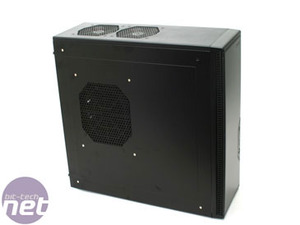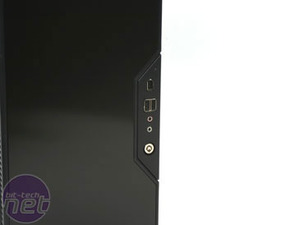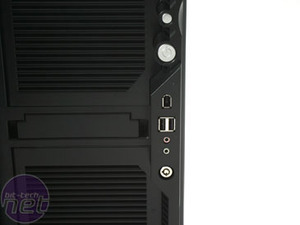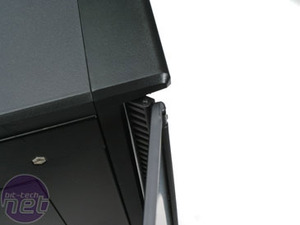
Manufacturer: Antec
UK Price (as reviewed): £239.92 (inc. VAT)
US Price (as reviewed): $355.00 (ex. Tax)
The Antec P190 got us all excited back when it was announced in May. We'd only just finished reviewing one of the case's predecessors, the Antec P182, and we were thoroughly impressed with it. The P182 will always have a special place in my heart in fact, as it was the first and only 10/10 score I've given since starting at bit-tech.
But could the P190, which has undergone several tweaks and a redesign for two PSUs, actually live up to the high standard of its older brother, or would it prove to be a useless and fiddly design that was either too close or too far from the original design? These were the questions that were spinning around in our heads as we ripped open the box and hefted the substantially weighted case out onto our desks.
Let's find the answers...
The case is heavy for a reason though because, as we found out when we removed a side-panel and baulked at the weight of a single panel, every side of the outer case is double layered to prevent noise. Also, unlike most cases which amount to little more than a tin box, the P190 is full of segmented chambers and cages – like a Russian doll, it's a box full of boxes.
The case also comes with its own PSUs – and that plural isn't a mistake. Antec has designed the whole case with the highest of high-end users in mind and the case is packaged with a new NeoLink PSU system which combines a NeoLink 650P and a NeoLink 550S to create a system with an output of 1200 watts. The idea is to connect the 650 watt PSU to the motherboard and graphics card and the 550 watt PSU to the peripheral drives and fans in a gloriously high-tech and globally warming way.
Obviously putting two PSUs in just adds to the weight.
Moving on to look at the aesthetics, the Antec P190 keeps roughly the same design as the P182 and the P180, by which we mean that it still looks a bit like a fridge. The looks may not be to everyone's exact taste, but the sleek and smooth exterior is inoffensive even to those people and we personally love it to bits. Subtle and understated, the case doesn't scream for attention and doesn't look out of place anywhere. It's a case with class, with the only branding on the outside being the almost invisible 'Antec' which is cut into the top right of the door.
Speaking of which, the door for the case is a great example of how flexibility can easily be incorporated into a stylish and solid design. Not only is the door solidly enough built – with a pin which ensures it locates correctly and holds steady when closing – but it also swings through 270 degrees thanks to a double hinge.
This means that if your desk is short on space then the door can be folded right round to be flush with the side of the case, but if there isn't enough room for that then the hinges can be clicked into a locked position to stop the door swinging back that far. It's an excellent and simple feature which users will undoubtedly appreciate every day.
The case has also seen some improvements over the last design, the P182. The most noticeable of which is the addition of extra fans on almost every single side of the case. Just from the outside we can see that there are two top mounted 140mm fans, a single side mounted 200mm fan and a 120mm fan on the back.
That's without counting the two PSU fans and the 120mm interior fan which circulates air away from the chambered PSUs. With rubberised ports for water-cooling too, we're fairly sure that cooling won't be an issue. One thing we did notice about the fans which led us to have a chuckle or two was that the fan controls on the back of the case for the top and rear fans have a spelling mistake on them.
The revised design has also streamlined the features of previous models, getting rid of the opinion-dividing chimney that slid on top of the P182 case. The case can fit more easily into tight spaces because of the omission, though falling debris (i.e. crisps, sweet wrappers, toe nail clippings, etc) pose more of a threat.
On the plus side, the case is undeniably well constructed with nary a rattle nor squeak to be coaxed from any hinge or button anywhere on the outsides. With a lockable door on top of this, it's a sure thing that this is a case which is built to last.
UK Price (as reviewed): £239.92 (inc. VAT)
US Price (as reviewed): $355.00 (ex. Tax)
The Antec P190 got us all excited back when it was announced in May. We'd only just finished reviewing one of the case's predecessors, the Antec P182, and we were thoroughly impressed with it. The P182 will always have a special place in my heart in fact, as it was the first and only 10/10 score I've given since starting at bit-tech.
But could the P190, which has undergone several tweaks and a redesign for two PSUs, actually live up to the high standard of its older brother, or would it prove to be a useless and fiddly design that was either too close or too far from the original design? These were the questions that were spinning around in our heads as we ripped open the box and hefted the substantially weighted case out onto our desks.
Let's find the answers...
He ain't heavy, he's my PC case
The first thing to say about the Antec P190 is how heavy it is, because it's really heavy. Not just heavy like when you're going on holiday and you pick up your girlfriend's suitcase full of shoes and you have to use both hands to lift it, all the while bemoaning the fact that nobody needs eighty-four pairs of trainers. No, this goes beyond that. It's more like when your girlfriend tries to carry your suitcase full of swords, screwdrivers and emergency supplies and she has to enlist the help of a forklift to lift it, all the while bemoaning the fact that because zombies aren't really real there is no need to prepare so fully for the zombie apocalypse.The case is heavy for a reason though because, as we found out when we removed a side-panel and baulked at the weight of a single panel, every side of the outer case is double layered to prevent noise. Also, unlike most cases which amount to little more than a tin box, the P190 is full of segmented chambers and cages – like a Russian doll, it's a box full of boxes.
The case also comes with its own PSUs – and that plural isn't a mistake. Antec has designed the whole case with the highest of high-end users in mind and the case is packaged with a new NeoLink PSU system which combines a NeoLink 650P and a NeoLink 550S to create a system with an output of 1200 watts. The idea is to connect the 650 watt PSU to the motherboard and graphics card and the 550 watt PSU to the peripheral drives and fans in a gloriously high-tech and globally warming way.
Obviously putting two PSUs in just adds to the weight.
Moving on to look at the aesthetics, the Antec P190 keeps roughly the same design as the P182 and the P180, by which we mean that it still looks a bit like a fridge. The looks may not be to everyone's exact taste, but the sleek and smooth exterior is inoffensive even to those people and we personally love it to bits. Subtle and understated, the case doesn't scream for attention and doesn't look out of place anywhere. It's a case with class, with the only branding on the outside being the almost invisible 'Antec' which is cut into the top right of the door.
Speaking of which, the door for the case is a great example of how flexibility can easily be incorporated into a stylish and solid design. Not only is the door solidly enough built – with a pin which ensures it locates correctly and holds steady when closing – but it also swings through 270 degrees thanks to a double hinge.
This means that if your desk is short on space then the door can be folded right round to be flush with the side of the case, but if there isn't enough room for that then the hinges can be clicked into a locked position to stop the door swinging back that far. It's an excellent and simple feature which users will undoubtedly appreciate every day.
The case has also seen some improvements over the last design, the P182. The most noticeable of which is the addition of extra fans on almost every single side of the case. Just from the outside we can see that there are two top mounted 140mm fans, a single side mounted 200mm fan and a 120mm fan on the back.
That's without counting the two PSU fans and the 120mm interior fan which circulates air away from the chambered PSUs. With rubberised ports for water-cooling too, we're fairly sure that cooling won't be an issue. One thing we did notice about the fans which led us to have a chuckle or two was that the fan controls on the back of the case for the top and rear fans have a spelling mistake on them.
The revised design has also streamlined the features of previous models, getting rid of the opinion-dividing chimney that slid on top of the P182 case. The case can fit more easily into tight spaces because of the omission, though falling debris (i.e. crisps, sweet wrappers, toe nail clippings, etc) pose more of a threat.
On the plus side, the case is undeniably well constructed with nary a rattle nor squeak to be coaxed from any hinge or button anywhere on the outsides. With a lockable door on top of this, it's a sure thing that this is a case which is built to last.

MSI MPG Velox 100R Chassis Review
October 14 2021 | 15:04














Want to comment? Please log in.